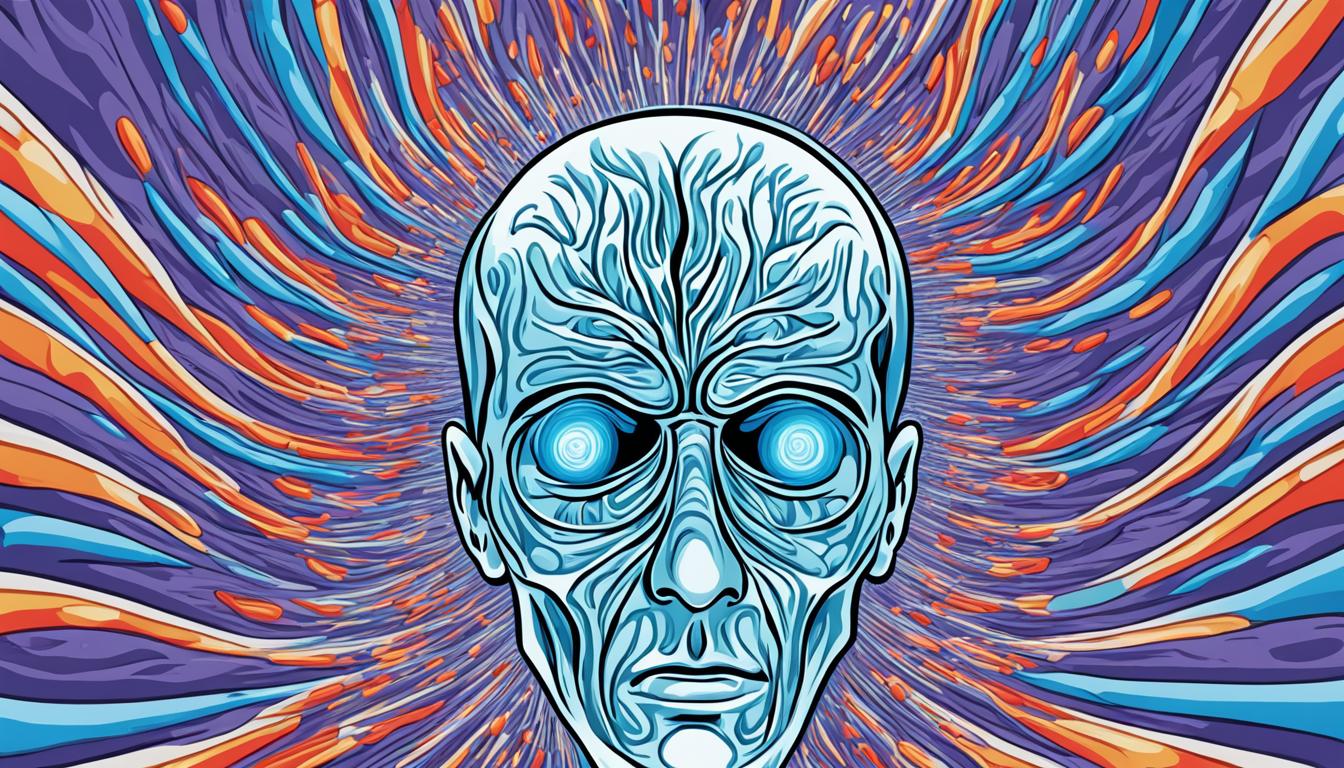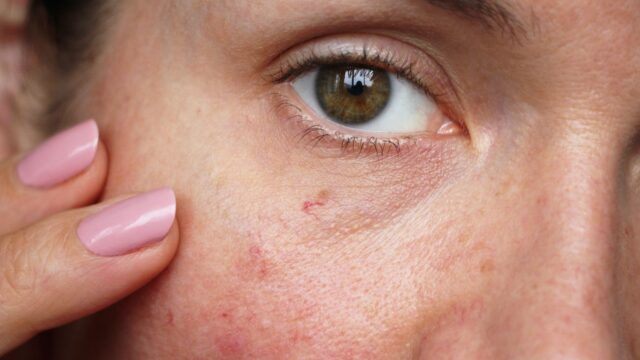FTC disclaimer: This post may contains affiliate links and we will be compensated if you click on a link and make a purchase.
Did you know that if you get migraines with aura, you’re a bit more likely to have a stroke? This kind of severe headache happens with about 25% of all migraines. The aura happens first. It’s signs like seeing flashing lights or feeling tingling in your hand or face. Then comes the bad head pain, feeling sick, and not liking bright lights or loud sounds.
The type of migraine with aura is also known as classic migraine. It keeps coming back and can come with vision changes or feeling like your skin is prickling. The treatment is often the same as for migraines without the aura. But it’s good to know the differences in symptoms, reasons, and ways to treat it. This can help you deal with it and lower how much it affects your life.
The signs of a migraine aura usually start about an hour before the headache. They often go away in 60 minutes. Sometimes, the aura happens on its own, especially if you’re over 50. People with aura might see strange things, have trouble speaking, or feel numb. A migraine with aura can also make you dizzy, make your ears ring, or make you find light too bright.
Key Takeaways
- Migraine with aura is a type of severe headache that occurs with temporary visual or other sensory disturbances.
- Aura symptoms usually strike before the migraine pain and can last up to an hour.
- Migraine with aura is more common in women and those with a family history of migraines.
- Treatments for migraine with aura are similar to those for common migraine, including medications and lifestyle changes.
- Recognizing the signs of migraine with aura is important, as it can be linked to a slightly increased risk of stroke in some cases.
Understanding Migraine With Aura
Migraine with aura is not just any headache. It comes with sensory changes before or as the pain starts. These changes vary but can include flashes of light or tingling in the hand. While about a quarter of migraines have auras, they don’t appear with every one. Some people might experience an aura without the head pain. An aura usually lasts less than an hour, disappearing shortly before the pain begins.
What is Migraine With Aura?
There are four main types of migraines that include auras. These are migraine with aura (with or without head pain), migraine with brainstem aura, hemiplegic migraines, and retinal migraines. Migraine with aura stands out because it comes with these temporary sensory or speech changes.,
Distinguishing Migraine With Aura from Other Migraines
Migraine with aura is distinct among the four types for its sensory changes. These can be seen in the form of visual, sensory, or speech disruptions, and they are temporary.,
Symptoms of Migraine With Aura
Many with migraine aura see temporary visual signs. These start in the center of their vision and move outwards. They might see blind spots, zigzags, shimmering spots, vision changes, or lights.
Visual Aura Symptoms
Visual auras are the most common. They happen when a wave of activity affects the visual part of the brain. This leads to things like zigzags or stars. About a quarter of migraines come with auras, and this doesn’t happen for every migraine. Some people, young or old, might only get an aura without the headache.
Sensory Aura Symptoms
Some may feel a hand or a side of their face go numb or tingle at first. This feeling might start slow and spread. Muscle weakness can also happen. About one third of people get warned 24 to 48 hours ahead, known as the prodrome.
Speech and Language Aura Symptoms
You might have trouble speaking, like not finding the right words, or maybe you mumble. This is less common. Aura often starts in childhood, gets worse in teen years, and becomes rare after 50.
Adults often feel migraine pain on one side of their head near their eyes. This pain can last from a few hours to up to 3 days.
Migraine With Aura Causes and Risk Factors
The causes of migraine with aura are still a mystery to us. Yet, studies suggest that a wave, either electrical or chemical, moves through the brain. This wave could pop up in areas linked to our senses, where we process speech, or in spots that control how we move. Where this happens decides what symptoms we see. The most usual aurora is visual. It happens when electrical alerts move through our eyes’ main area, causing strange sights like blind spots, wavy lines, flashes, and shimmering spots.
Understanding the Electrical Wave Theory
This moving electrical or chemical wave is linked to episodes of “cortical spreading depression.” It triggers the brain to release certain chemicals. These chemicals make our blood vessels wider and swollen. This enlarging of blood vessels causes the typical aura signs of migraines.
Genetic and Environmental Risk Factors
Although specific risks for getting migraines with aura aren’t clear, having a family history of migraines hints that you might be more likely to get one. Further, migraines, even those with auras, are more usual in women than in men. Many things that might cause regular migraines can also lead to migraines with aura. These include stress, bright lights, certain foods and meds, bad sleep, and changes in hormones.
Knowing about the possible causes and risks can help people who get these migraines. It can guide them in finding ways to manage or lessen how often and how hard the migraines hit.
Diagnosing Migraine With Aura
Diagnosing migraine with aura starts with your medical history and a checkup. Your doctor will learn about your headaches, their type, how often they happen, and if you see auras. They will ask if others in your family have migraines, what can start your headaches, and the drugs you use. When you are physically examined, the doctor will test your reflexes, muscles, senses, and speaking to see how your brain is working.
Ruling Out Other Conditions
To make sure it’s not something else causing your symptoms, your doctor might ask for more tests. These could include blood tests, eye checks, or pictures of your brain like CT or MRI scans.
These tests look for problems such as an infection or bleeding that might cause your headaches. After digging into your medical history and doing a complete checkup, your doctor can find if you have migraine with aura. Then, they’ll make a plan for your treatment.
Treatment Options for Migraine With Aura
Acute Migraine Treatments
When a migraine with aura strikes, find a quiet, dark spot. Try using cold packs or gentle pressure on sore spots. You can use over-the-counter pain meds like acetaminophen. You might also try NSAIDs such as aspirin, ibuprofen, or naproxen. Your doctor might give you stronger NSAID doses.
They could also prescribe quick-acting meds like triptans, ditans, and ergots. These are known as acute or abortive medications because they stop the pain fast. If you feel sick to your stomach, other medicines can help with that. There are even special devices like TMS and vagus nerve stimulators. They aim to stop a migraine in its tracks.
Preventive Medications
If your migraines happen often (four or more days a month) and other treatments don’t help, there’s another option. Your doctor may recommend drugs to prevent them. These can include seizure meds, blood pressure meds, and antidepressants. There’s also a new kind of drug called CGRP inhibitors.
Non-Pharmacological Therapies
Managing stress and keeping regular sleep and eating times can make a big difference. These techniques can lower how often migraines come and how bad they are. It’s also a good idea to keep a headache diary. Writing when they happen and what you feel can help your doctor figure out the best plan. It can also help you see if the treatments are working over time.
Managing and Preventing Migraine With Aura
Identifying and Avoiding Triggers
To manage and prevent migraine with aura, you need to spot and dodge your triggers. Common triggers include some foods, alcohol, certain drugs, stress, and being tired. Hormone shifts and flashing lights can also set off migraines. Keeping a headache diary is key.
Write the date, time, what you ate, what you were doing, and any medicines you used before the migraine. It might take weeks to see a pattern, but this info is crucial for taking care of your health.
Lifestyle Modifications
Apart from steer clear of triggers, changing your lifestyle can also help. Aim for enough sleep, find ways to lower stress like using biofeedback, eat healthily, and exercise often. Doing these things helps lessen how often and how bad your migraines are. By making your health a top concern, you can keep migraines at bay.

Migraine With Aura: Symptoms, Causes, and Treatments
Migraine with aura, or classic migraine, is a headache that often comes with odd sights or feelings before the pain. You might see flashes of light or have a tingly face or hand. The treatments for this kind of migraine are similar to those without aura.
You can sometimes stop an aura migraine with medicine or by taking care of yourself. This is done to prevent the headache before it starts.
Migraine aura usually starts less than an hour before the head pain. It can go away in less than 60 minutes. Half of those with migraines have these symptoms.
When the aura strikes, you may see blind spots or funny patterns. It might seem like lines are zigzagging or you’re looking through a wavy glass. You could even feel like parts of your body are numb or your speech is off.
Some people, because of their family history, are more likely to get migraines. Women tend to get them more than men. If you have migraine with aura, your stroke risk might go up slightly.
About 25% of migraines come with auras, but not everyone’s migraine starts this way. Some get warning signs a day or two before. This is when they might feel odd or notice things seem different. Migraines with aura can vary in type, from classic to specific nerve-related migraines.
During an aura, you might notice strange smells or sounds, or feel parts of your body tingle. Even your speech can get mixed up, making it hard to talk right. The pain, when it comes, often feels like a strong beat on one side of your head.
Migraines seem to come down families more often. They can start in childhood and get more frequent during teenage years. These headaches might be caused by changes in the brain and result in pain.
Many ways to deal with migraines, from medicines to special devices, are out there. If you get migraines often, there are drugs that can help make them less severe or stop them from happening.
It’s also good to know what makes your migraines start. This could be certain foods, feeling stressed, or when your hormones change. Avoiding these triggers might keep your headaches away. Sometimes, you might get an ocular migraine, affecting only one eye, or a kind of seizure needing its own treatment.
Migraine aura could come before a stroke, but this is very rare. Knowing the signs and getting help quickly can reduce this risk. This underlines the importance of recognizing when a migraine is not just a migraine, and getting medical attention right away.
Distinguishing Migraine With Aura from Other Conditions
Both ocular migraine and migraine with aura affect how we see. The main difference is that ocular migraine influences just one eye. It’s rarer than migraine with aura, which impacts up to 33% of migraine sufferers.
Ocular Migraine vs. Migraine With Aura
Ocular migraine and migraine with aura change vision, but ocular migraine only affects one eye. This type, also called retinal migraine, is less common than migraine with aura.
Epilepsy Aura vs. Migraine Aura
Epilepsy’s aura, a focal aware seizure, might last seconds to minutes. It warns of a serious seizure and can make you feel déjà vu, uneasy, joyful, or scared. Other signs are weird taste, numbness, pain, dizziness, nausea, or nervousness. Conversely, migraine aura symptoms involve visual, sensory, or speech changes and are brief, under an hour.

Potential Complications of Migraine With Aura
Migraine with aura can bring some serious issues, such as a higher stroke risk. This type of migraine is not common in stroke cases, happening in less than 1%. Even so, experts don’t fully understand the link.
They do know having a history of migraine with aura increases your stroke risk. This is especially true for women under 45. The risk might rise due to hormone changes and more chances of blood clots from birth control.
Increased Risk of Stroke
Knowing the warning signs of a stroke is vital if you get migraines with aura. Watch for vision problems or tingling, plus signs like not being able to move one side well, confusion, or a strong headache. Being alert to these clues and getting help fast can help you avoid big problems.
Recognizing Stroke Symptoms
If you have migraine with aura, learn the signs of a stroke. They include sudden weakness on one side, not being able to talk clearly, vision issues, feeling dizzy, or a bad headache. If you think you’re having a stroke, it’s important to get help right away. Knowing these signs can save your life.
Conclusion
Migraine with aura is a type of headache that comes with sensory issues. These issues include seeing flashes of light, having blind spots, and feeling tingling in your hand or face. The treatments for this type of migraine and regular migraine are mostly the same.
You can try the same medicines and self-care tips to stop it happening. Knowing the signs, causes, and how to treat migraine with aura is key. It helps you handle the condition better and lower how much it disrupts your life.
Monoclonal antibody therapies have cut down the number of migraine days for about half the patients in big phase 3 tests. But, there will be decisions about who gets this treatment. This is true, especially in places with few resources and when facing other major health problems.
Also, different races and ethnicities may not get equal treatment and care for their migraines. This could be why the burden of migraines varies among different groups.
Learning about the signs, causes, and treatments for migraine with aura is important. It helps you take better care and lessen its effect on your health and well-being. The right care and support can help you get through the hard times caused by migraine with aura. It can make your life better.
FAQ
What is migraine with aura?
Migraine with aura is a type of headache that some people get. It can make you see flashing lights or feel tingly. These things happen before the headache starts. They are called aura.
How does migraine with aura differ from other types of migraine?
Migraine with aura is different because it causes you to have strange things happen before the headache pain comes. This could mean seeing things that aren’t there or feeling parts of your body go numb. It is a specific kind of migraine.
What are the symptoms of migraine with aura?
People with migraine with aura might see flashing lights or zigzag lines. They could also feel parts of their body go numb. Some people have trouble talking or find it hard to move their muscles.
This all happens before the actual headache starts.
What causes migraine with aura?
Migraine with aura may happen because of waves moving across your brain. These waves affect different parts, causing different symptoms. Things like stress, bright lights, or even certain foods can start a migraine attack.
How is migraine with aura diagnosed?
To diagnose migraine with aura, your doctor will ask about your headaches and do a physical exam. They will test how your nerves are working. You might also have some blood tests or scans to make sure there is no other health problem.
How is migraine with aura treated?
When you have a migraine with aura, you can take medicine for the pain. It’s also helpful to rest in a quiet, dark room. Your doctor might give you special medicines to prevent or stop the migraines if these don’t help.
It’s also important to stay away from things that trigger your migraines.
How can I prevent migraine with aura?
Staying away from things that trigger your migraines is the best way to not have them. This could include avoiding certain foods, getting enough sleep, and managing stress. Keeping a record of your headaches can help you identify your triggers.
Also, leading a healthy lifestyle with good sleep, stress management, and eating well helps prevent migraines.
How is migraine with aura different from other conditions like ocular migraine and epilepsy aura?
Migraine with aura and ocular migraine are similar but different. Ocular migraine affects only one eye, while migraine with aura makes you have strange feelings or numbness.
An epilepsy aura is a sign that a seizure might happen. It can make you feel like you have seen something before or feel dizzy or sick.
Can migraine with aura increase the risk of stroke?
Migraine with aura might slightly increase the risk of a stroke. This is very rare, happening in less than 1% of cases. But if you are a woman under 45 or use certain birth control, this risk might be a bit higher.








